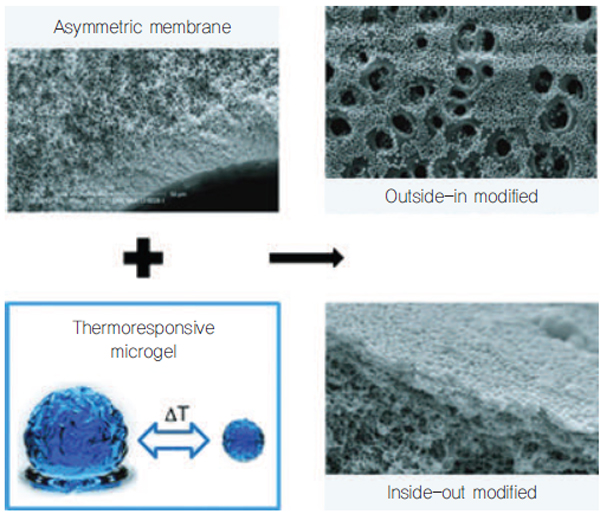독일, 마이크로젤 기반 열반응 멤브레인 개발
독일, 마이크로젤 기반 열반응 멤브레인 개발
온도 따라 용액 흐르거나 멈추게 하는 중공사막 만드는데 성공
멤브레인 필터(Membrane filter)를 이용한 여과(Filtration)는 분리에 이용되는 가장 일반적인 기술 중 하나이다. 현재 기술이 발달함에 따라 연구자들은 스위칭이 가능하며 원하는 분리 속성을 지닌 멤브레인을 만드는 것을 목표로 하고 있다. 최근, 독일의 연구원들이 마이크로젤을 결합시킴으로써 멤브레인을 변형시키는 간단한 기술을 개발하는데 성공했다.
『Angewandte Chemie』지에‘Temperature-Modulated Water Filtration Using Microgel-Functionalized Hollow-Fiber Membranes’라는 제목으로 게재된 논문에서, 연구자들은 열반응성 마이크로젤(thermoresponsive microgel)을 이용해 온도에 따라 흐르기도 하고 멈추기도 하는 중공사막(hollow-fiber membrane)을 만드는데 성공했다.
아헨공대(RWTH Aachen University)와 라이프니츠 연구소(DWI, Leibniz Institute)의 연구자들은 공동 연구를 통해 물의 초미세 혹은 미세 여과에 이용하기 위해 상업적으로 이용이 가능한 중공사막을 사용했다. 중공사막 필터는 내부의 통로를 통해 반투과물질로 이루어진 섬유다발로 구성되어 있다. 섬유의 벽은 막처럼 움직이게 된다. 또한 멤브레인을 변형시키기 위해 Matthias Wessling이 이끄는 연구팀은 마이크로젤 용액을 간단하게 여과시켰다.
젤(gel)은 액체로 채워진 3차원 분자 네트워크를 이루고 있다. 스펀지에 존재하는 물과 달리, 젤에 존재하는 물은 단단하게 결합되어 있다. 젤의 마이크로 입자들은 마이크로젤(microgel)이라고 불린다. 연구자들은 섭씨 32도에서 안정적인 폴리비닐카프로락탐(polyvinylcaprolactam)으로 만들어진 마이크로젤을 이용했다. 이 이상의 온도에서 젤은 붕괴되고 물은 빠져나가게 된다.
사용된 중공사막은 비대칭의 포어 구조를 지니고 있으며 포어의 크기는 미세필터의 경우 200nm이고 초미세의 경우 30nm이 되도록 했다. 연구자들이 만들어낸 마이크로젤 결합 중공사막의 투과성은 다른 것들에 비해 매우 낮았는데, 그 이유는 마이크로젤이 포어에 접근하는 것을 어렵게 만들기 때문이다.
온도를 증가시키는 것은 마이크로젤을 수축하게 만들어 멤브레인의 투과성을 증가시켜 주었고 그 반대의 경우가 온도를 낮추어주었을 때 일어났다. 이러한 스위칭 메커니즘은 효과적인 중공사막을 만드는 데 있어서 매우 중요하다.
이에 대해 Wessling은 “자극 반응성 마이크로젤을 지닌 일반적인 중공사막의 변형은 새로운 속성과 투과성의 조절이 가능한 다기능성 멤브레인을 만드는데 도움이 된다. 마이크로젤이 지닌 다양한 화학구조가 독특한 기능성을 제공하고 있다”고 덧붙였다.

Microgel-based thermoresponsive membranes for water filtration
Filtration using membrane filters is one of the most commonly used separation techniques. Modern developments are aimed at membranes with tailored separation properties as well as switchability. German scientists have now developed a very simple method for the modification of membranes through the inclusion of microgels. In the journal Angewandte Chemie ("Temperature-Modulated Water Filtration Using Microgel-Functionalized Hollow-Fiber Membranes"), they introduce hollow-fiber membranes that demonstrate temperature-dependent flow and retention, thanks to thermoresponsive microgels.
The researchers from RWTH Aachen University and DWI-Leibniz Institute for Interactive Materials used commercially available hollow-fiber membranes used for the ultra- and microfiltration of water. Hollow-fiber filters consist of bundles of fibers made of a semipermeable material with a channel on the inside. The walls of the fibers act as the membrane. In order to modify the membranes, a team led by Matthias Wessling simply filtered microgel suspensions through them. This allowed the microgels to become embedded into the porous structure of the membrane.
A gel is a three-dimensional molecular network that is filled with a liquid. Unlike the liquid in a sponge, the liquid in the gel is tightly bound. Microparticles of a gel are called microgels. The researchers used microgels made of polyvinylcaprolactam that are stable to about 32℃. Above this temperature, the gel structure collapses, letting the water out.
The hollow-fiber membranes used have an asymmetric pore structure with internal diameters of 30 nm (ultrafiltration) to 200 nm (microfiltration) and external diameters of several micrometers. The fibers can be loaded with the microgels either from the outside in or from the inside out.
In the first method the gel particles penetrate partway into the pores and the outside is then coated with microgel. In the second method, gel particles are only found on the interior of the pores, but not in those pores that are very narrow. In both types of fibers, the microgel is so firmly adsorbed that it cannot be washed away either during filtration or back flushing.
The permeability of both types is significantly reduced relative to the untreated membrane, because the microgel makes the pores less accessible. Raising the temperature causes the microgel to shrink, increasing the permeability of the membrane; cooling reverses the effect. This switching mechanism could be an important method for an efficient cleaning of the hollow fiber when high flow rates are needed during a backwashing step at low temperatures.
“The modification of conventional hollow-fiber membranes with stimuli-responsive microgels provides a straightforward and versatile route to design functional membranes with new, tailored properties that allow for regulation of the permeability,” says Wessling.
“Varying the chemical structures of the microgels allows for the introduction of specific functionalities into membranes, increasing the efficiency and selectivity of separation processes in water treatment and medical technology. We will further develop this versatile platform by fundamental research within the SFB Functional Microgels and Microgel Systems of the German Research Foundation (DFG).”
[출처 = KISTI 미리안(http://mirian.kisti.re.kr) 『글로벌동향브리핑』 2014년 4월 28일 / 원문출처 = www.nanowerk.com/nanotechnology_news/newsid=35306.php]
[『워터저널』 2014년 5월호에 게재]

